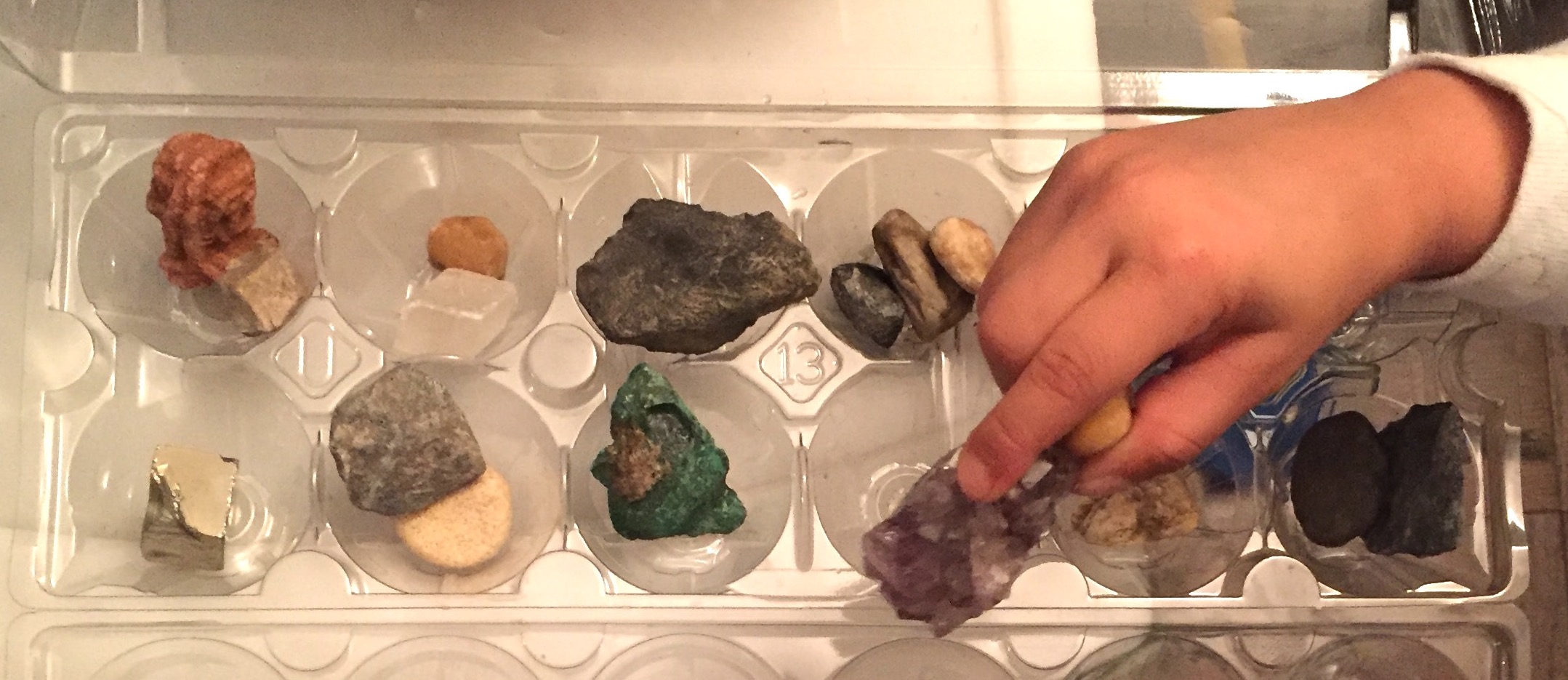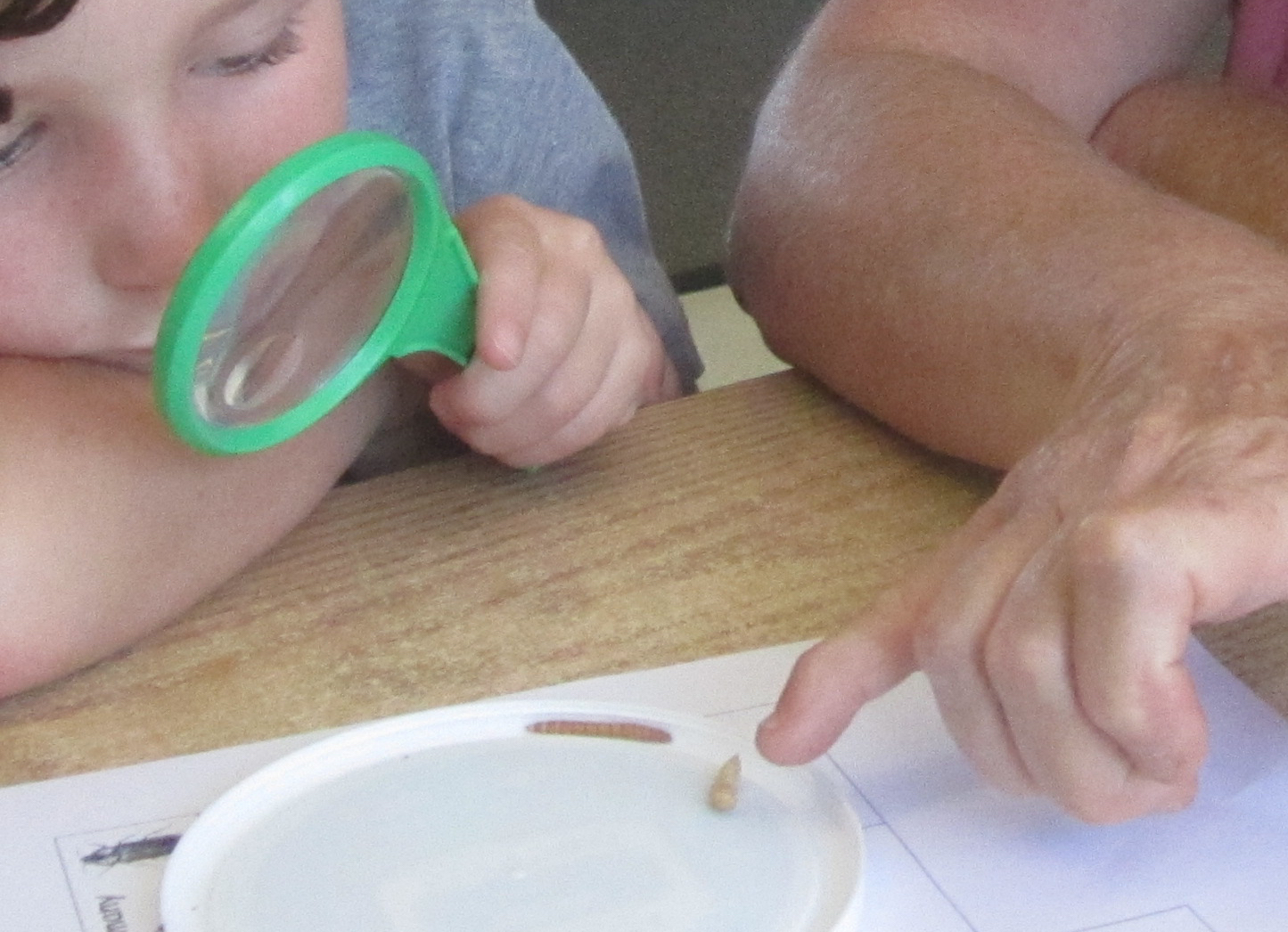Matter and Energy for Growth and Activity, Student Edition
Matter and Energy for Growth and Activity, Teacher Edition
Intentionally providing materials to sort
By Peggy Ashbrook
Posted on 2019-11-26
In addition to providing materials for children, we can ask ourselves, “What is my role as an educator when I provide materials for sorting?” If we were picking through lentils to sort out any wee stones before cooking, our job would be to give children experiences and information to help them identify what is a stone and what is a lentil. If we are sorting laundry to be washed, we would give children experiences and information about color bleeding and absorption to help them understand the reason for sorting. What is the reason for sorting a basket of multicolored and various sized plastic bears? Through sorting activities children are introduced to the idea of attributes, such as size, color, and weight. Non-uniform natural materials with more variation between items provide more challenging sorting experiences. “This rock is biggest.” “And the other rocks are littler.” An educator might ask, “How many different sizes are there?” Or, “Can they be put in a line from biggest to smallest?” Children will have ideas of their own on how the rocks should be sorted.

Sorting is one way to use and make sense of data. It is a way to classify living organisms, materials and objects. Through many experiences making observations of earthworms, children learn that earthworms do not have legs. This knowledge helps them classify caterpillars and other larvae (such as beetle larvae often called “mealworms”) as not-worms but something else. They may decide that something else is an insect based on two attributes—the presence of legs, and having six legs. And put millipedes in a separate group based on their “many, many” legs.
One of the Erikson Institute Early Math Collaborative’s Big Ideas is that “attributes can be used to sort collections into sets.” “Young children who understand the Big Idea that attributes can be used to sort collections into sets have a working knowledge of what a set is and how it is constructed.”
In Incorporating Math into Your Cold-Weather Routines, Math at Home blogger Diann Gano describes how she uses sets of cold-weather gear to help preschool children learn routine and patterns and sequence while teaching them to be self-sufficient. See her photos of a two-year-old demonstrating the “firefighter flip” for getting the jacket on with arms in the correct armholes. In another post Gano relates how collected natural materials involved children in arranging the materials, sorting and creating patterns.
“One major use of pattern recognition is in classification, which depends on careful observation of similarities and differences; objects can be classified into groups on the basis of similarities of visible or microscopic features or on the basis of similarities of function” (NRC). Patterns is one of the Next Generation Science Standards (NGSS) Crosscutting Concepts, concepts that bridge disciplinary boundaries, uniting core ideas throughout the fields of science and engineering.
Having an intention for offering materials for children’s use means we have some idea of what children are capable of and what they will learn through using the materials. Children may have other ideas—they usually do! In the Early Years column in the November 2019 issue of Science and Children I wrote about how children’s sorting ideas made me reconsider how the random grouping of model (toy) animals in one tub on the shelf affected how children sorted them, and perhaps led to some misconceptions.
National Research Council (NRC). 2012. A Framework for K-12 Science Education: Practices, Crosscutting Concepts, and Core Ideas. Washington, DC: The National Academies Press.
In addition to providing materials for children, we can ask ourselves, “What is my role as an educator when I provide materials for sorting?” If we were picking through lentils to sort out any wee stones before cooking, our job would be to give children experiences and information to help them identify what is a stone and what is a lentil. If we are sorting laundry to be washed, we would give children experiences and information about color bleeding and absorption to help them understand the reason for sorting.
Volume 1, Issue 12
STEM Mindset
Volume 1, Issue 12
STEM Mindset
Volume 1, Issue 12
STEM Mindset
Star Light, Star Bright
By Gabe Kraljevic
Posted on 2019-11-25
 I was planning a lesson for fifth grade about constellations. If you have any ideas, I would love to hear them.
I was planning a lesson for fifth grade about constellations. If you have any ideas, I would love to hear them.
—B., Illinois
Students often develop the misconception that constellations are two-dimensional. It’s like looking at a road map and never understanding that there is a three-dimensional topography to the land. I would stress that the stars in a constellation are almost all at different distances from Earth. Your students can research their own constellations to make three-dimensional models which, when viewed from the right direction, form the shape we know. The American Museum of Natural History has some related activities http://bit.ly/346dKi0.
Students should make some night observations of stars, the Moon, and planets. There are many online maps to download for each month of the year. Have students learn the prominent constellations and how to use “finder stars.” Have your students construct planispheres—simple paper-and-card stock dial maps that you rotate to the correct time and date for observation. There are many to choose from online such as this one from Sky & Telescope: http://bit.ly/2po0Q0f.
Why not make the lesson cross-curricular? The sky map we follow reflects Greek culture from two and a half millennia ago. The names and stories of the constellations are interesting to students as they ponder why there is a harp (Lyra) and a winged horse (Pegasus) in the sky, and who was Perseus? Give them a star map without lines or names. Ask them to make up their own constellations and stories. I can bet you that they will see cell phones, anime characters and pop stars.
Hope this helps!
Image by Gerd Altmann from Pixabay
 I was planning a lesson for fifth grade about constellations. If you have any ideas, I would love to hear them.
I was planning a lesson for fifth grade about constellations. If you have any ideas, I would love to hear them.
—B., Illinois
Discovery Engineering in Biology: Case Studies for Grades 6–12
Bring STEM Practices Into the Secondary Classroom
By Juan-Carlos Aguilar, Anne Petersen, Megan Schrauben
Posted on 2019-11-19
STEM—Science, Technology, Engineering, and Mathematics—is discussed in the news, politics, and education journals, yet what does it really mean for classrooms? The Council of State Science Supervisors (CSSS) works to support secondary science in various ways, including through the efforts of its STEM committee. The STEM committee is now focusing on determining current practices in STEM education across the United States and providing educators with instructional best practices to help them prepare students for higher education and the workforce.
What is STEM instruction?
Many articles about STEM instruction focus on opportunities for collaboration, development of the 5 C’s (communication, collaboration, citizenship, and critical and creative thinking), integrated instruction, teamwork, opportunities for hands-on activities, relevant problem solving, and the use of problem-project-, or place-based learning. The question now is this: How does STEM instruction differ from good instruction, and what practices can classroom teachers use to create a STEM classroom?
In the secondary science classroom, STEM education can be viewed as instruction that integrates mathematical, engineering, English language arts, and science concepts in a meaningful way. It also provides opportunities for students to apply these concepts to real- world problems through the use and development of technology, thus preparing them for the workforce. And STEM education allows for the seamless development of skills and/or industry-recognized credentials while intentionally introducing students to possible career paths.
How can teachers create a climate that fosters STEM education?
Creating a STEM climate within a school or team is not accomplished through the work of one teacher in a single discipline. Teachers should collaborate to explore opportunities for integrated curriculum and create a plan for reaching all students. In developing this STEM climate, several factors should be considered.
Aligning language, terms, and processes
Many students and teachers work in silos within a secondary setting. The prevailing thought is that science should be taught and learned in science class and mathematics should be taught and learned in mathematics class. As science educators, we know that math is the language of science. If we use different terms or phrases for mathematics and its processes in our science class, then the mathematics teachers’ terminology and phrasing may confuse students, particularly those with low efficacy in mathematics. Mathematics, science, and Career and Technical Education (CTE) teachers should meet regularly to review the terms used in each of the respective disciplines to ensure the terminology is consistent for students.
Identifying areas of discipline alignment
It can be difficult to determine opportunities for cross-curricular instruction among high school disciplines, particularly when students are accelerated in one subject but not in another. However, it is possible.
For example, students may learn about the chemistry gas laws first in Algebra II because gas laws provide mathematics teachers an authentic application for inverse and direct proportions. In biology, statistics are used in many scientific studies and align with the elementary statistics concepts taught in many Algebra I and II courses. In a CTE culinary class, students can study the effect of pH on the preparation of cakes, thus reinforcing the concepts of pH taught in many different science courses. Manipulating data in large data sets is a skill taught in computer science; however, science may allow for generating questions that will lead to using and analyzing this data, particularly in the areas of astronomy and meteorology. Computer science allows us to synthesize large data sets that would be very difficult, if not impossible, to do by hand.
In addition, students from multiple disciplines may participate in the same engineering design challenge; however, the content approach may vary based on the course. A science class can study rockets through a physics lens, while an Algebra II student may describe or predict the path of a rocket using quadratic formulas. A computer-aided design (CAD) student may take the same challenge and create a CAD schematic of the prototype before building the actual prototype, while a trigonometry student may use tangents to determine the rocket’s height. Collaborating in discipline teams helps identify areas of alignment and encourages planning of shared projects.
Educating students about career pathways
One argument for STEM education is the need for skilled applicants for STEM jobs. Students need to be aware of the variety of STEM careers they can pursue, as well as the academic pathways that would best prepare them for these careers. Quality STEM instruction should also develop budding entrepreneurs—or the next group of empowered innovators. Teachers and counselors should be knowledgeable about these fields, and with guidance from higher education and businesses, steer students to coursework that best prepares them for these careers.
A colleague once said STEM education is an ecosystem within good instruction that prepares students for growing job fields. Through our own collaborative work as educators, we must provide students with the content, skills, and processes needed to succeed in STEM fields. Go Team STEM!
 Juan-Carlos Aguilar is director for Innovative Programs and Research at the Georgia Department of Education. He provides internal evaluation support for innovative projects awarded to the State Department of Education and manages a portfolio of projects funded by the National Science Foundation, the U.S. Department of Education, and private foundations. For nine years, he served as state liaison for science, engineering, and STEM professional organizations. He has also participated in national STEM organizations, most currently as a member of the National Academies of Sciences, Engineering, and Medicine’s America’s Lab Report committee. As past president of CSSS, Aguilar coordinated projects designed to support states as they adopted and implemented the Next Generation Science Standards (NGSS) and oversaw the development of Professional Development Standards in collaboration with CSSS Higher Education partners.
Juan-Carlos Aguilar is director for Innovative Programs and Research at the Georgia Department of Education. He provides internal evaluation support for innovative projects awarded to the State Department of Education and manages a portfolio of projects funded by the National Science Foundation, the U.S. Department of Education, and private foundations. For nine years, he served as state liaison for science, engineering, and STEM professional organizations. He has also participated in national STEM organizations, most currently as a member of the National Academies of Sciences, Engineering, and Medicine’s America’s Lab Report committee. As past president of CSSS, Aguilar coordinated projects designed to support states as they adopted and implemented the Next Generation Science Standards (NGSS) and oversaw the development of Professional Development Standards in collaboration with CSSS Higher Education partners.
 Anne Petersen is a science coordinator with the Virginia Department of Education. She has worked in rural and urban public school divisions as both a biology and chemistry teacher and as a science supervisor. In addition, she was an adjunct professor at the College of William and Mary, where she taught a secondary science education course for preservice teachers. Petersen earned her doctorate in Education Policy, Planning, and Leadership at the College of William and Mary.
Anne Petersen is a science coordinator with the Virginia Department of Education. She has worked in rural and urban public school divisions as both a biology and chemistry teacher and as a science supervisor. In addition, she was an adjunct professor at the College of William and Mary, where she taught a secondary science education course for preservice teachers. Petersen earned her doctorate in Education Policy, Planning, and Leadership at the College of William and Mary.
 Megan Schrauben is Michigan’s MiSTEM Network Executive Director, which includes facilitating the activities of the Governor’s MiSTEM Advisory Council and granting dollars for STEM programming. MiSTEM’s state office is housed at the Department of Labor and Economic Opportunity (LEO) and coordinates efforts with the Michigan Department of Education (MDE). Schrauben holds a BS in physics and mathematics education from the University of Michigan and a Master’s of Applied Science from Michigan Technological University. During her tenures at these institutions, her passion for integrated STEM instruction evolved from research internships at CERN in Switzerland, Fermilab near Chicago, the National Superconducting Cyclotron Laboratory at MSU, and a teaching/engineering position in Santa Cruz, Bolivia. Before joining the LEO department, Schrauben taught high school physics and math in Jackson, Michigan; was director of the Mathematics and Science Center in Jackson County, where she also served as president of the Michigan Mathematics and Science Centers Network; then moved to the MDE, where she was the Integrated Instruction Consultant. Currently she serves as Director at Large for CSSS and as an appointed member of the Governor’s Future Talent Council 21st-Century Talent Creation Subcommittee.
Megan Schrauben is Michigan’s MiSTEM Network Executive Director, which includes facilitating the activities of the Governor’s MiSTEM Advisory Council and granting dollars for STEM programming. MiSTEM’s state office is housed at the Department of Labor and Economic Opportunity (LEO) and coordinates efforts with the Michigan Department of Education (MDE). Schrauben holds a BS in physics and mathematics education from the University of Michigan and a Master’s of Applied Science from Michigan Technological University. During her tenures at these institutions, her passion for integrated STEM instruction evolved from research internships at CERN in Switzerland, Fermilab near Chicago, the National Superconducting Cyclotron Laboratory at MSU, and a teaching/engineering position in Santa Cruz, Bolivia. Before joining the LEO department, Schrauben taught high school physics and math in Jackson, Michigan; was director of the Mathematics and Science Center in Jackson County, where she also served as president of the Michigan Mathematics and Science Centers Network; then moved to the MDE, where she was the Integrated Instruction Consultant. Currently she serves as Director at Large for CSSS and as an appointed member of the Governor’s Future Talent Council 21st-Century Talent Creation Subcommittee.
Note: This article is featured in the November 2019 issue of Next Gen Navigator, a monthly e-newsletter from NSTA delivering information, insights, resources, and professional learning opportunities for science educators by science educators on the Next Generation Science Standards and three-dimensional instruction. Click here to sign up to receive the Navigator every month.
The mission of NSTA is to promote excellence and innovation in science teaching and learning for all.
STEM—Science, Technology, Engineering, and Mathematics—is discussed in the news, politics, and education journals, yet what does it really mean for classrooms? The Council of State Science Supervisors (CSSS) works to support secondary science in various ways, including through the efforts of its STEM committee. The STEM committee is now focusing on determining current practices in STEM education across the United States and providing educators with instructional best practices to help them prepare students for higher education and the workforce.






